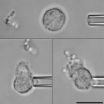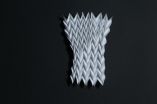(Press-News.org) Typhoid fever is caused by systemic (body-wide) infection with Salmonella enterica Typhi. In contrast, infection with the closely related bacterium Salmonella enterica Thyphimurium is usually limited to the gut and causes less serious diarrheal disease. Research published on August 7th in PLOS Pathogens comparing the two pathogens reveals how S. Typhi avoids recognition and elimination by patrolling immune cells called neutrophils, allowing it to disseminate throughout the patient's body.
Neutrophils track down microbial invaders and gobble them up. To investigate why some Salmonella strains trigger a neutrophil response but others don't, researchers led by Volkmar Heinrich and Andreas Bäumler from the University of California at Davis, USA, designed a way to directly observe the interaction between a single bacterium and a single neutrophil cell. They immobilized the bacterium with laser tweezers in close proximity to a neutrophil held by a tiny glass pipette.
A close encounter with S. Typhimurium provokes an obvious response by the neutrophil: the initially round immune cell bulges out towards the bacterium, getting ready to make contact and ingest the intruder. Proximity to S. Typhi, in contrast, stimulates no visible changes. This differential response depends on a "natural" immune response environment, that is, on the presence of human blood serum.
To get at the signals revealing the presence of S. Typhimurium—which are somehow absent in (or obstructed by) the presence of S. Typhi—the researchers used a second experimental set up. In a so-called Boyden chamber, either bacteria or chemicals that attract neutrophils are concentrated in a bottom compartment that is filled with human blood serum. Neutrophils are initially concentrated in the upper compartment, and their migration to the bottom is quantified.
As expected, the presence of S. Typhimurium caused migration of neutrophils to the bottom compartment. This response was blocked by a drug that inhibits the complement system, a part of the non-specific immune system present in human blood. As for the difference between S. Typhimurium and S. Typhi, the researchers could show that a particular part of the outer layer of S. Typhi—the so-called Vi capsular polysaccharide—was responsible for inhibiting the complement-dependent attraction of neutrophils. When they generated S. Typhi lacking the Vi capsular polysaccharide and tested them in both experimental settings, they found that these behaved just like S. Typhimurium, i.e. evoked the "reach-out" response in pipette-held neutrophils and, in the Boyden chamber, elicited migration of neutrophils to the bottom compartment.
Because the researchers found that mouse neutrophils behaved just like human neutrophils in these experiments, they then tested whether they could recapitulate the difference "in vivo", i.e. in mice infected with both intact S. Typhi and with S. Typhi lacking the Vi capsular polysaccharide. Indeed, in these mice, neutrophils were found preferentially in association with the latter bacteria. Finally, in mice with a defective complement system, there was no visible preference of neutrophils for either of the two types of S. Typhi.
The data, including striking videos*, the researchers say, "illustrate that the Vi capsular polysaccharide can act as a "cloaking device" that makes S. Typhi practically "invisible" to neutrophils". Their results, they add, "suggest that one of the differences between [milder] gastroenteritis and [dangerous] typhoid fever is that the pathogen causing the latter disease evades neutrophil chemotaxis".
INFORMATION:
*Please e-mail plospathogens@plos.org for a copy of the videos that will publish with this article.
Please contact plospathogens@plos.org if you would like more information about our content and specific topics of interest.
All works published in PLOS Pathogens are open access, which means that everything is immediately and freely available. Use this URL in your coverage to provide readers access to the paper upon publication:
http://dx.plos.org/10.1371/journal.ppat.1004306 (Link goes live upon article publication)
Contact:
Volkmar Heinrich
e-mail: vheinrich@ucdavis.edu
phone: +1.530.754.6644
Andreas Bäumler
e-mail: ajbaumler@ucdavis.edu
phone: +1.530.754.7225
Authors and Affiliations:
Tamding Wangdi, University of California Davis, USA
Cheng-Yuk Lee, University of California Davis, USA
Alanna M. Spees, University of California Davis, USA
Chenzhou Yu, University of California Davis, USA
Dawn D. Kingsbury, University of California Davis, USA
Sebastian E. Winter, University of California Davis, USA
Christine J. Hastey, University of California Davis, USA
R. Paul Wilson, University of California Davis, USA
Volkmar Heinrich, University of California Davis, USA
Andreas J. Bäumler, University of California Davis, USA
Funding: This project was supported by Public Health Service grant AI044170 to AJB. We would also like to acknowledge the NIH Facilities Infrastructure Grant 1-C06-RR12088-01. The funders had no role in study design, data collection and analysis, decision to publish, or preparation of the manuscript.
Competing Interests: The authors have declared that no competing interests exist.
Citation: Wangdi T, Lee C-Y, Spees AM, Yu C, Kingsbury DD, et al. (2014) The Vi Capsular Polysaccharide Enables Salmonella enterica Serovar Typhi to Evade Microbe-Guided Neutrophil Chemotaxis. PLoS Pathog 10(8): e1004306. doi:10.1371/journal.ppat.1004306
The typhoid fever pathogen uses a cloaking mechanism to evade neutrophil neutralization
2014-08-07
ELSE PRESS RELEASES FROM THIS DATE:
Stanford researchers use fruit flies to unlock mysteries of human diabetes
2014-08-07
For the first time, the tiny fruit fly can be used to study how mutations associated with the development of diabetes affect the production and secretion of the vital hormone insulin.
The advance is due to a new technique devised by researchers at the Stanford University School of Medicine that allows scientists to measure insulin levels in the insects with extremely high sensitivity and reproducibility.
The experimental model is likely to transform the field of diabetes research by bringing the staggering power of fruit fly genetics, honed over 100 years of research, ...
Small, origami-inspired pop-up robots function autonomously
2014-08-07
This release is available in Japanese.
Inspired by the traditional Japanese art form of Origami or "folding paper," researchers have developed a way to coax flat sheets of composite materials to self-fold into complex robots that crawl and turn.
"We demonstrated this process by building a robot that folds itself and walks away without human assistance," said Sam Felton, a Ph.D. candidate at Harvard University's School of Engineering and Applied Sciences and the Wyss Institute for Biologically Inspired Engineering and the lead author of a new report in the 8 August ...
Ocean's most oxygen-deprived zones to shrink under climate change
2014-08-07
As the complex story of climate change unfolds, many of the endings are grim. But there are exceptions. Predictions that the lowest-oxygen environments in the ocean would get worse may not come to pass. Instead, University of Washington research shows climate change, as it weakens the trade winds, could shrink the size of these extreme low-oxygen waters.
"The tropics should actually get better oxygenated as the climate warms up," said Curtis Deutsch, a UW associate professor of oceanography. He is lead author of the study published Aug. 8 in Science.
Warmer water contains ...
Water 'microhabitats' in oil show potential for extraterrestrial life, oil cleanup
2014-08-07
PULLMAN –An international team of researchers has found extremely small habitats that increase the potential for life on other planets while offering a way to clean up oil spills on our own.
Looking at samples from the world's largest natural asphalt lake, they found active microbes in droplets as small as a microliter, which is about 1/50th of a drop of water.
"We saw a huge diversity of bacteria and archaea," said Dirk Schulze-Makuch, a professor in Washington State University's School of the Environment and the only U.S. researcher on the team. "That's why we speak ...
Orally delivered compounds selectively modify RNA splicing, prevent deficits in SMA models
2014-08-07
Today the journal Science published results of a preclinical study demonstrating that treatment with orally available RNA splicing modifiers of the SMN2 gene starting early after birth is preventing deficits in a mouse model of Spinal Muscular Atrophy (SMA). Scientists from Roche Pharma Research and Early Development (pRED), PTC Therapeutics, Inc., the SMA Foundation, the University of Southern California and Harvard University collaborated to demonstrate that continuous treatment of SMA mice with these compounds increased life span, normalized body weight and prevented ...
Study reveals dynamics of microbes and nitrate
2014-08-07
Human tampering with global carbon balances has received massive public attention because of its effects on global warming, but we pay less attention to another set of chemical processes we are similarly disrupting: human input to the nitrogen cycle. Unfortunately, the story of nitrogen transformations in the biosphere is also less understood.
In modern times, humans developed the technology to turn nitrogen gas in the atmosphere into a biologically available form to be used as fertilizer. Before this, bio-available or "fixed" nitrogen was only created sparingly by natural ...
Origami could lead to exotic materials, tiny transformers
2014-08-07
ITHACA, N.Y. – Embracing the pleats, creases and tucks of the Japanese art of decorative paper folding, Cornell University researchers are uncovering how origami principles could lead to exotic materials, soft robots and even tiny transformers.
Publishing online in the journal Science Aug. 8, an interdisciplinary team led by Cornell's Itai Cohen, associate professor of physics, and graduate student Jesse Silverberg have discovered how to use a well-known origami folding pattern called the Miura-ori to control fundamental physical properties of any thin sheet of material.
Video, ...
Step closer to birth of the sun
2014-08-07
Researchers are a step closer to understanding the birth of the sun.
Published in Science, the team led by Dr Maria Lugaro and Professor Alexander Heger, from Monash University, have investigated the solar system's prehistoric phase and the events that led to the birth of the sun.
Dr Lugaro, from the Monash Centre for Astrophysics, said the team used radioactivity to date the last time that heavy elements such as gold, silver, platinum, lead and rare-earth elements were added to the solar system matter by the stars that produced them.
"Using heavy radioactive nuclei ...
Finding the genetic culprits that drive antibiotic resistance
2014-08-07
Researchers have developed a powerful new tool to identify genetic changes in disease-causing bacteria that are responsible for antibiotic resistance. The results from this technique could be used in clinics within the next decade to decide on the most effective treatments for diseases such as pneumonia and meningitis.
The team looked at the genome of Streptococcus pneumoniae, a bacterial species that causes 1.6 million deaths worldwide each year. In the most detailed research of its kind, scientists used a genome-wide association study (GWAS) to locate single-letter ...
Learning from origami to design new materials
2014-08-07
AMHERST, Mass. -- A challenge increasingly important to physicists and materials scientists in recent years has been how to design controllable new materials that exhibit desired physical properties rather than relying on those properties to emerge naturally, says University of Massachusetts Amherst physicist Christian Santangelo.
Now he and physicist Arthur Evans and polymer scientist Ryan Hayward at UMass Amherst, with others at Cornell and Western New England University, are using origami-based folding methods for "tuning" the fundamental physical properties of any ...


